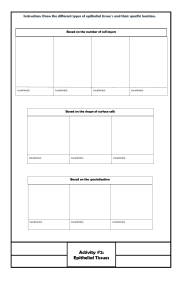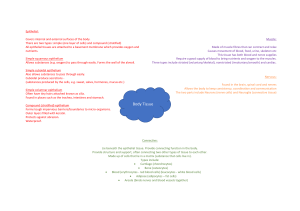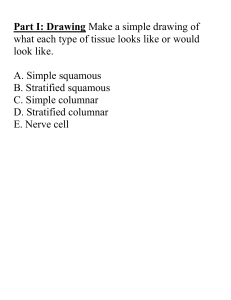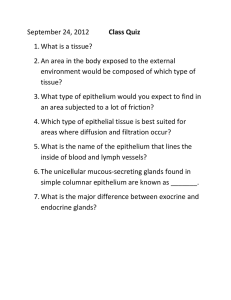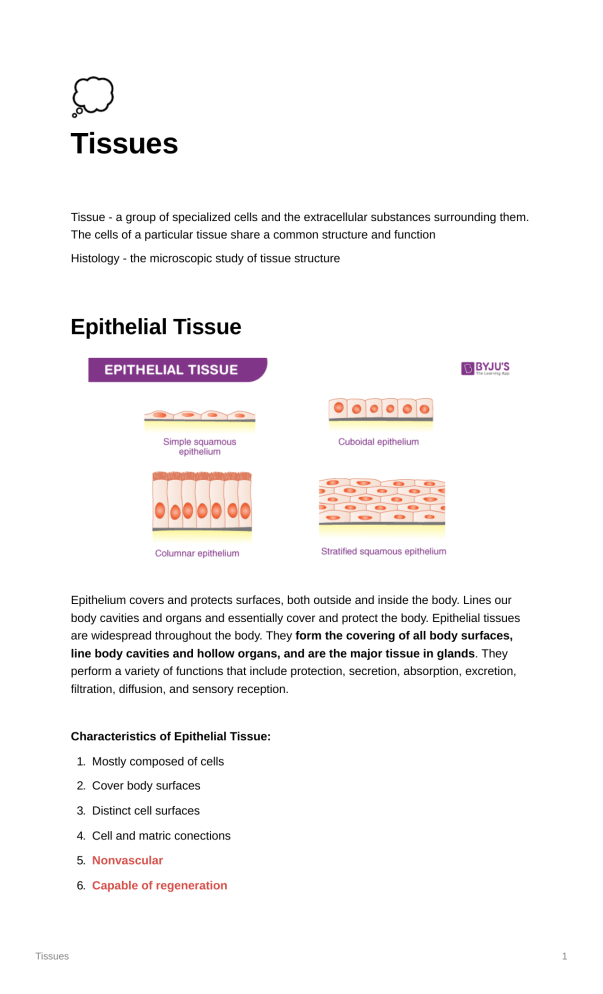
💭 Tissues Tissue - a group of specialized cells and the extracellular substances surrounding them. The cells of a particular tissue share a common structure and function Histology - the microscopic study of tissue structure Epithelial Tissue Epithelium covers and protects surfaces, both outside and inside the body. Lines our body cavities and organs and essentially cover and protect the body. Epithelial tissues are widespread throughout the body. They form the covering of all body surfaces, line body cavities and hollow organs, and are the major tissue in glands. They perform a variety of functions that include protection, secretion, absorption, excretion, filtration, diffusion, and sensory reception. Characteristics of Epithelial Tissue: 1. Mostly composed of cells 2. Cover body surfaces 3. Distinct cell surfaces 4. Cell and matric conections 5. Nonvascular 6. Capable of regeneration Tissues 1 Major Functions of Epithelial Tissue: 1. Protects underlying structures 2. Acting as a barrier 3. Permitting the passage of substances 4. Secreting substances 5. Absorbing Substances Protection: Epithelial tissue protects several aspects of your body. For example, your skin is made up of epithelial tissue and protects the tissues deeper in your body, such as blood vessels, muscle and internal organs. The cilia on the epithelial cells that line your intestines protect the rest of your body from intestinal bacteria. Secretion: Epithelial tissue in your glands (glandular epithelium) can secrete (release) enzymes, hormones and fluids. Absorption: The epithelial lining of your internal organs, such as your liver and lungs, can allow the absorption of certain substances. For example, the internal epithelial lining of your intestines absorbs nutrients from the food you eat. Excretion: Excretion is the removal of waste from your body. The epithelial tissue in your kidneys excrete waste, and the epithelial tissue in your sweat glands excrete sweat. Filtration: The epithelium of your respiratory tract filters out dirt and particles and cleans the air that you breathe in. Epithelial tissue in your kidneys filters your blood. Diffusion: In biology, diffusion is the passive movement of molecules or particles from regions of higher concentrations to regions of lower concentration. Simple squamous epithelial cells form a membrane that allows selective diffusion of materials to pass through. Diffusion helps with filtration, absorption and secretion functions. Sensory reception: Sensory nerve endings that are embedded in epithelial tissue allow your body to receive outside sensory stimuli. As an example, the stereocilia on the surface of the epithelial tissue in your ear are essential for hearing and balance. In addition, your taste buds are embedded in the stratified squamous epithelium of your tongue. Classifications of Epithelial Tissue: Tissues 2 1. Simple epithelium - is made of a single layer of cells. It functions as a lining for ducts, body cavities, and tubes. 2. Stratified epithelium - consists of more than one layer of cells. The function of this type of epithelium is mostly protective - the higher the number of layers, the more protective it is. It is good at withstanding abrasion. Consists of more than one layer of cells, but only the basal layer attaches the deepest layer to the basement membrane 3. Pseudostratified columnar epithelium - tissues formed by a single layer of cells that give the appearance of being made from multiple layers, especially when seen in cross section. Three Types of Epithelial Cells (based on shapes): 1. Squamous - cells are flat or scalelike 2. Cuboidal - cells are cube shaped 3. Columnar - tall and thin, cells tend to be taller than they are wide Simple Epithelium Tissues 3 Simple Squamous Epithelium single layer of thin, flat cells they are flat which makes it easy for material like oxygen to move across them to the other side. absorption or transportation; air sacs of lungs and blood vessels Simple Cuboidal Epithelium single layer of cube-like cells that carry out active transport, facilitated diffusion or secretion have cilia that move mucus over the free surface or microvilli that increase the surface area for secretions and absorption Simple Columnar Epithelium single layer of tall thin cells and with its size, these cells enables them to perform complex functions produces and secretes mucus and digestive enzymes. Mucus is a clear, thick fluid that protects the lining of the intestine Pseudostratified Columnar Epithelium Pseudostratified ciliated columnar epithelial cells found most heavily along the respiratory tract, help trap and transport particles brought in through the nasal passages and lungs. cilia in the airways move the mucus and accumulated debris toward the throat, where it is swallowed Stratified Epithelium Tissues 4 Stratified Squamous Epithelium forms a thick epithelium because it consists of several layers of cells This type of epithelium usually has protective functions, including protection against microorganisms from invading underlying tissue and/or protection against water loss. The outer layer of your skin (the epidermis) is made of stratified squamous epithelial cells. Stratified Cuboidal Epithelium a type of epithelial tissue composed of multiple layers of cube-shaped cells. for absorption, secretion, and protection Stratified Columnar Epithelium a rare type of epithelial tissue composed of column-shaped cells arranged in multiple layers. It is found in the conjunctiva, pharynx, anus, and male urethra. mainly the protection of underlying tissues with multiple layers of epithelial cells. Also, they perform secretion. Transitional Epithelium primary function of transitional epithelium is to enable tissue to contract and expand. For example, the inner walls of the urinary bladder are lined with transitional epithelium, a tissue which enables the bladder to enlarge when the bladder is filled with urine. Glands are secretory organs. Glands are composed primarily of epithelium with a supporting network of connective tissue Exocrine vs Endocrine Glands Tissues 5 glands with ducts are called exocrine glands. Both glands and ducts are lined with epithelium glands who has no ducts are called endocrine glands cellular products of endocrine glands are hormones which are secreted into the bloodstream and carried throughout the system Connective Tissue Functions: Tissues 6 1. enclosing and separating other tissues 2. connecting tissues to one another 3. supporting and moving parts of the body 4. storing compounds 5. cushioning and insulating 6. transporting 7. protecting Classification of Connective Tissue 1. connective tissue proper (loose and dense) - found in ligaments and supporting the skin 2. supporting connective tissue (cartilage and bone) - allows growth of long bones (cartilage) and provides great strength and support and protects internal organs (bones). Cartilage is mostly present in the embryonic stages and works as a supporting skeleton. Most of the cartilage is replaced by bones in adults, however, it supports some structures in adults too. In humans, cartilage is present between the bones of the vertebral column, in the external ear, nose and hands. Bone is the hardest connective tissue and helps in maintaining the shape and posture of the body, it protects internal organs. They are rich in collagen fibres and calcium, which give strength. 3. fluid connective tissue (blood) - transports oxygen, carbon dioxide, hormones, nutrients, waste products and other substances. Protects the body from infections Muscle Tissue main function of muscle tissue is to contract and making movement possible. Muscle contraction results from contractile proteins located within the muscle Types Tissues 7 1. Skeletal - for movement of the body under voluntary control; muscle tissue has cells or fibers appears striated (banded) 2. Cardiac - pumps the blood under involuntary control 3. Smooth - physiological function of smooth muscle cells is involuntary contraction. Smooth muscle tissues typically contain several cells, contraction of which induces movements ranging from peristalsis of digested food along the gut to piloerection of body hair. Cells that are tapered at each end, are not striated and have a single nucleus Nervous Tissue Tissues 8 forms the brain, spinal cord and nerves. It is responsible for coordinating and controlling many body activities. It stimulates muscle contraction, creates an awareness of the environment, and plays a major role in emotions, memory, and reasoning. Tissue Membrane A tissue membrane is a thin layer or sheet of cells that covers the outside of the body (for example, skin), the organs (for example, pericardium), internal passageways that lead to the exterior of the body (for example, abdominal mesenteries), and the lining of the moveable joint cavities. Types of Tissue Membrane 1. skin (external) - The cutaneous membrane is the technical term for our skin. The skin’s primary role is to help protect the rest of the body’s tissues and organs from physical damage such as abrasions, chemical damage such as detergents, and biological damage from microorganisms. For example, while the skin harbors many permanent and transient bacteria, these bacteria are unable to enter the body when healthy, intact skin is present. 2. Mucus - Mucosa is another name for mucous membrane. Mucosa lines the insides of organs and cavities throughout your body that are exposed to particles from the outside. The mucous membrane lubricates and protects these organs and cavities from abrasive particles and bodily fluids, as well as invasive pathogens 3. Serous - Serous membranes line and enclose several body cavities, also known as serous cavities, where they secrete a lubricating fluid that reduces friction from movements. Tissues 9 4. Synovial - The synovial membrane (or synovium ) is the connective tissue which lines the inner surface of the capsule of a synovial joint and secretes synovial fluid which serves a lubricating function, allowing joint surfaces to smoothly move across each other. Tissues 10
